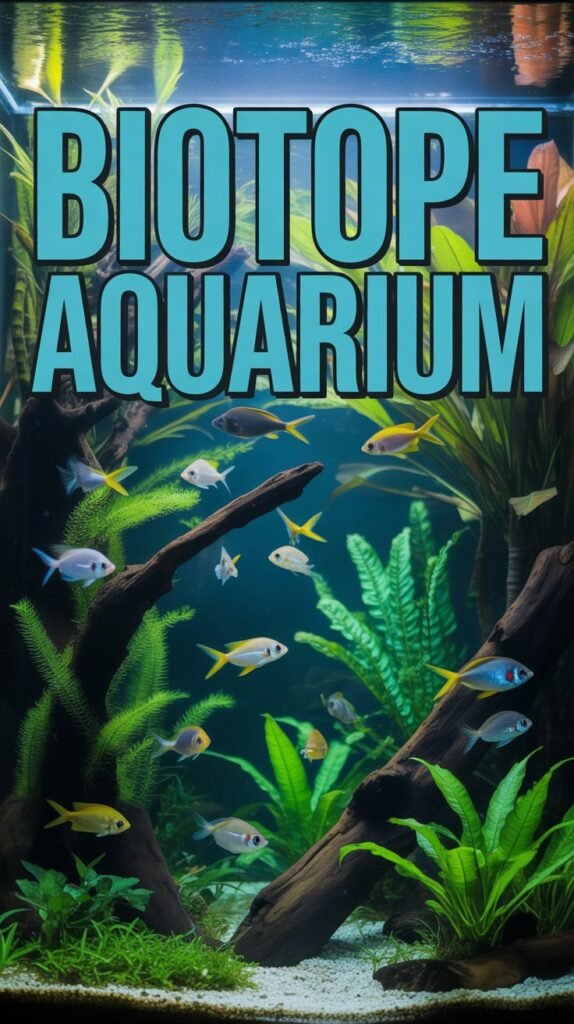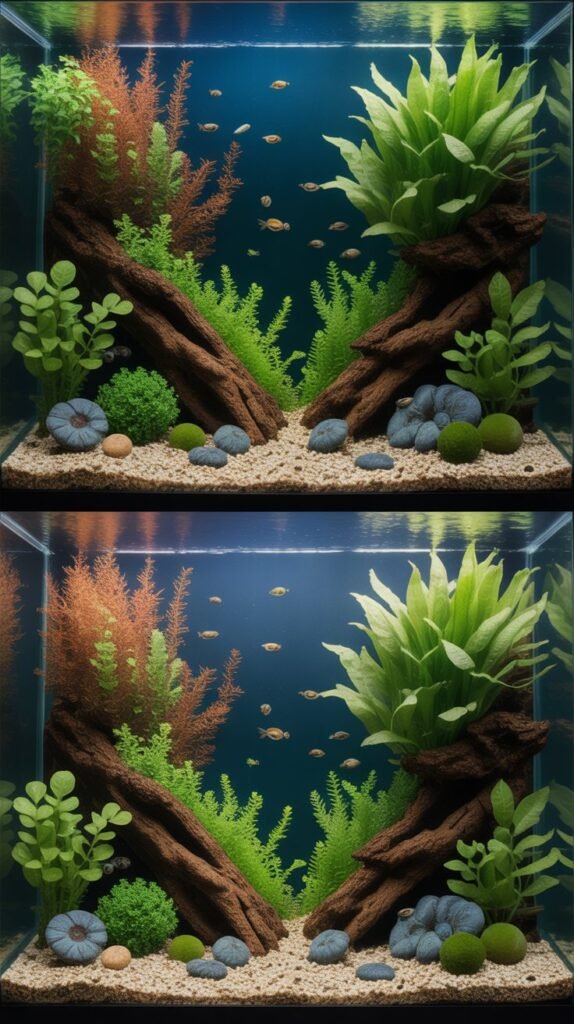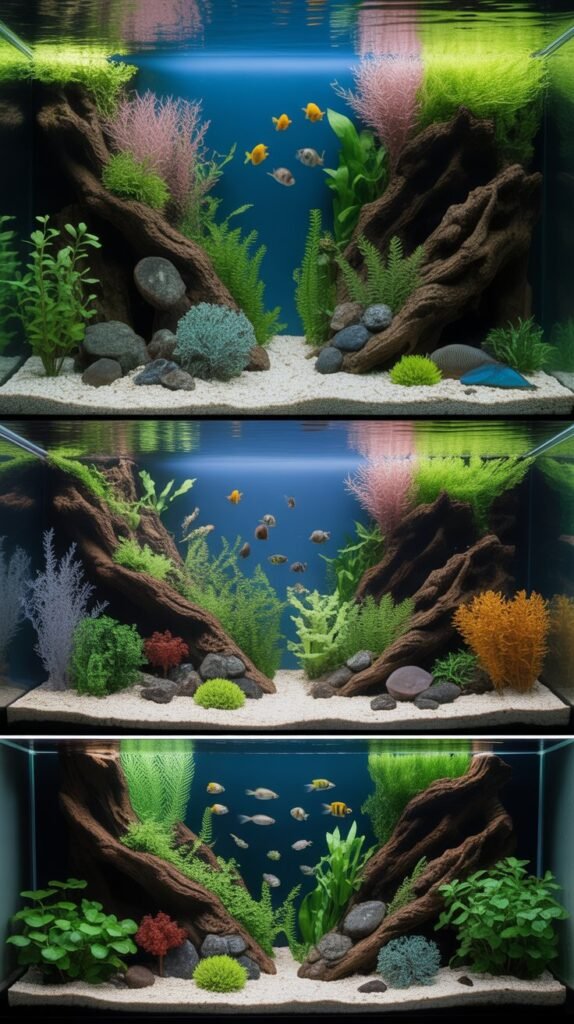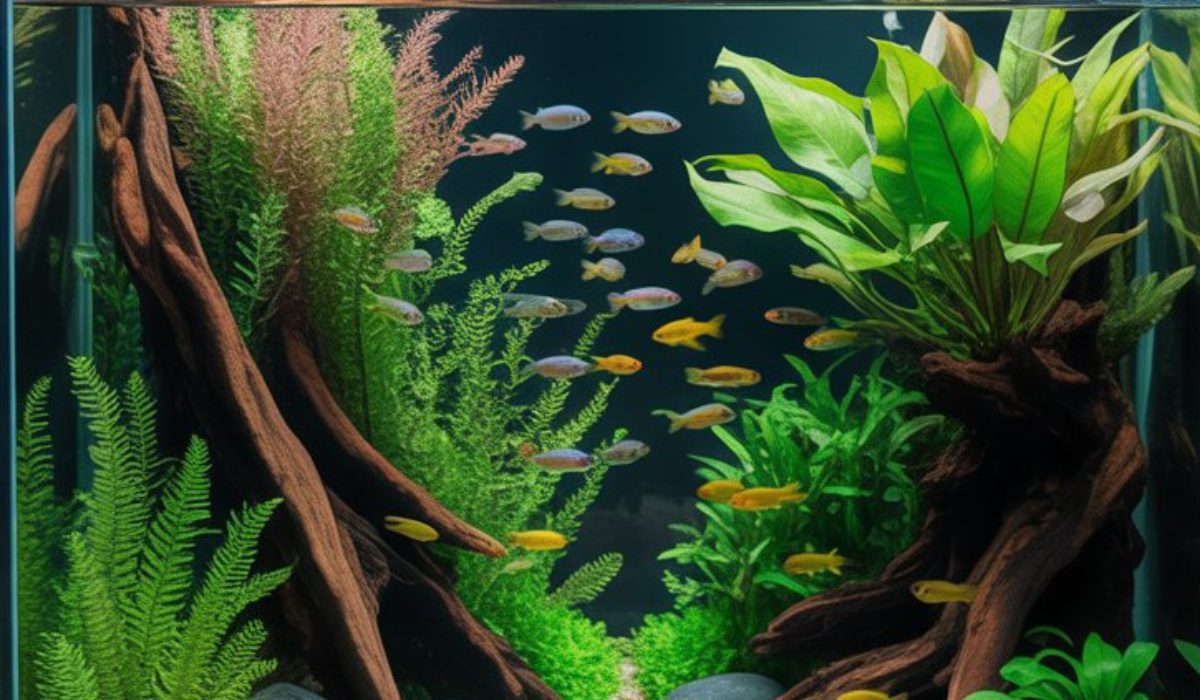In the world of aquarium keeping, few setups are as fascinating and educational as the biotope aquarium. More than just a fish tank, a biotope aquarium is a carefully crafted miniature version of a real natural habitat — a living work of art that reflects a specific region, river, or lake ecosystem.
Each element in a biotope — from the fish and plants to the rocks, driftwood, and even the water parameters — is selected to mimic a real environment as closely as possible. It’s not only beautiful to look at, but also an opportunity to learn about nature, ecology, and aquatic behavior.
In this comprehensive guide, we’ll explore everything you need to know about biotope aquariums — including their history, types, setup, species selection, maintenance, and FAQs.
What Is a Biotope Aquarium?
A biotope aquarium is a setup designed to replicate a specific natural aquatic habitat found in the wild. The goal is to recreate, as closely as possible, the environmental conditions, flora, and fauna of that chosen region.
For example:
- A Amazon River biotope might feature soft, acidic water, driftwood, and species like neon tetras or angelfish.
- An African Rift Lake biotope could include alkaline water, rocky caves, and cichlids.
- A Southeast Asian stream biotope might feature leaf litter, low light, and species like rasboras or gouramis.
Each biotope tells a story — a slice of nature carefully reconstructed inside your aquarium.
The Philosophy Behind Biotope Aquariums

Biotope aquariums go beyond decoration — they embody the philosophy of authenticity. Unlike community tanks that mix fish from different regions, a biotope aquarium emphasizes harmony and realism. Every detail — from substrate color to plant species — is chosen for ecological accuracy.
The key idea is to replicate, not just decorate.
It’s about respecting the natural relationships between fish, plants, and their environments.
This approach benefits both aquarists and aquatic life:
- Fish feel more comfortable and display natural behaviors.
- Plants thrive in authentic conditions.
- The aquarist gains insight into nature’s balance.
Benefits of a Biotope Aquarium
1. Natural Beauty
A biotope aquarium captures the raw beauty of untouched nature. The colors, textures, and layouts are naturally harmonious.
2. Healthier Fish
When fish live in conditions similar to their native habitats — water chemistry, light levels, and vegetation — they experience less stress, leading to stronger immune systems and better behavior.
3. Educational Value
Creating a biotope encourages research into geography, ecology, and biology. It’s a living lesson in environmental awareness.
4. Realistic Aquascaping
Biotopes follow natural design principles — uneven substrate, scattered leaf litter, and organic arrangements — offering a more authentic look than artificial decorations.
5. Eco-Conscious Approach
A biotope aquarium teaches respect for natural habitats and inspires aquarists to support conservation and responsible fishkeeping.
Types of Biotope Aquariums
There are many types of biotopes, each representing a unique ecosystem. Below are the most popular ones.
1. Amazon River Biotope
Region: South America
Features:
- Soft, acidic water (pH 5.5–7.0)
- Driftwood, fallen leaves, dim lighting
- Sandy substrate
Common Fish: Neon tetras, angelfish, discus, Corydoras catfish
Plants: Amazon sword, floating Salvinia, Vallisneria
2. African Lake Biotope
Region: Rift Lakes (Malawi, Tanganyika, Victoria)
Features:
- Hard, alkaline water (pH 7.8–8.6)
- Rocky caves and minimal plants
- Bright lighting
Common Fish: African cichlids, Mbuna species
Plants: Vallisneria, Anubias
3. Southeast Asian Stream Biotope
Region: Thailand, Indonesia, Malaysia
Features:
- Tannin-rich brown water
- Leaf litter, smooth stones, and roots
- Moderate to low light
Common Fish: Betta, rasboras, gouramis, loaches
Plants: Cryptocoryne, Java fern, Java moss
4. Central American River Biotope
Region: Mexico, Honduras, Nicaragua
Features:
- Moderate flow, sandy substrate, driftwood
- Neutral to slightly alkaline water
Common Fish: Swordtails, mollies, platies, cichlids
Plants: Sagittaria, Vallisneria
5. North American Pond Biotope
Region: USA and Canada
Features:
- Cold or temperate water
- Gravel substrate, reeds, and rocks
- Gentle current
Common Fish: Dace, shiners, small sunfish
Plants: Hornwort, elodea, water lilies
6. African River Biotope
Region: Congo Basin
Features:
- Soft, slightly acidic water
- Dark substrate, wood, and branches
Common Fish: Congo tetra, butterfly fish
Plants: Anubias, Bolbitis heudelotii
7. Australian Billabong Biotope
Region: Northern Australia
Features:
- Clear or slightly murky water
- Sand and wood debris
- Open swimming areas
Common Fish: Rainbowfish, gudgeons, blue-eyes
Plants: Vallisneria, floating ferns
Planning Your Biotope Aquarium

Before starting your setup, research your chosen region thoroughly. Consider the following factors:
1. Region Selection
Choose a biotope that interests you — whether tropical rivers, forest streams, or mountain lakes. Look for:
- Water type (hard or soft)
- Temperature
- Flow pattern (still or fast-moving)
- Natural light levels
2. Aquarium Size
While biotopes can be built in any tank, a 20 to 55-gallon aquarium offers flexibility for plants, fish, and decor.
3. Research the Ecosystem
Gather information on:
- Fish species native to the region
- Plant life
- Substrate type (sand, gravel, or soil)
- Decor elements (wood, rocks, leaves)
Use reference photos and videos from the wild for inspiration.
Essential Equipment for a Biotope Aquarium
Even though the look should appear natural, proper equipment ensures stability and balance.
1. Filter
Choose a filter that mimics the water flow of the natural environment:
- Canister filters for rivers and lakes.
- Sponge filters for gentle streams or calm waters.
2. Heater
Set the temperature according to your biotope’s region.
- Tropical biotopes: 24–28°C
- Temperate biotopes: 18–22°C
3. Lighting
Select lighting based on plant needs and realism:
- Soft, dim lighting for shaded streams.
- Bright light for open lakes or ponds.
4. Substrate
Use sand, soil, or gravel that matches the habitat’s color and texture. Avoid artificial colors.
5. Decorations
Natural decor elements are essential:
- Driftwood, branches, stones, leaf litter.
- Avoid plastic ornaments; they disrupt realism.
6. Water Conditioner and Testing Kit
Maintain pH, hardness, and temperature within regional parameters.
Regular testing ensures long-term balance.
Setting Up a Biotope Aquarium: Step-by-Step

Step 1: Research Your Target Habitat
Learn about the chosen biotope’s environment, plant species, and fish behavior. Watch underwater videos for authenticity.
Step 2: Prepare the Aquarium
Rinse your tank and equipment thoroughly (no soap).
Step 3: Add the Substrate
Create a natural landscape. Slopes or uneven ground make the setup realistic.
Step 4: Place Hardscape
Add rocks, roots, and driftwood in a natural pattern — not symmetrical or overly arranged.
Step 5: Add Plants
Choose plants native to your chosen biotope. Plant densely in background areas and sparsely in front.
Step 6: Fill the Tank
Fill slowly using dechlorinated water to avoid disturbing the layout.
Step 7: Install Equipment
Attach the filter, heater, and lighting. Set the temperature and flow rate appropriately.
Step 8: Cycle the Aquarium
Before adding fish, cycle the tank for 4–6 weeks to establish beneficial bacteria.
Step 9: Introduce Fish Gradually
Add a few fish at a time to allow the ecosystem to stabilize.
Step 10: Monitor Water Parameters
Test regularly and adjust as needed to maintain authenticity.
Best Fish for Biotope Aquariums
The ideal fish depend on the habitat you’re recreating. Here are a few examples:
| Biotope | Recommended Fish |
|---|---|
| Amazon River | Neon tetra, angelfish, Corydoras |
| African Lake | Mbuna cichlids, Peacock cichlids |
| Asian Stream | Betta, rasboras, gouramis |
| North American Pond | Shiners, sunfish |
| Australian Billabong | Rainbowfish, gudgeons |
Always choose fish that coexist naturally in the wild.
Live Plants for Biotope Aquariums
While not all biotopes feature plants (some African lakes are rocky), plants add realism and improve water quality. Here are some biotope-friendly plants:
| Region | Plant Species |
|---|---|
| Amazon | Amazon sword, Vallisneria, floating Salvinia |
| Africa | Anubias, Bolbitis, Vallisneria |
| Asia | Cryptocoryne, Java fern, Java moss |
| North America | Elodea, hornwort |
| Australia | Vallisneria, floating ferns |
Biotope Aquascaping Tips
- Study Nature: Avoid symmetry — nature is irregular.
- Layer the Landscape: Use rocks and wood to create depth and flow.
- Color Harmony: Match substrate and decor tones to the natural setting.
- Add Leaf Litter: Especially in Amazon and Asian biotopes; it releases tannins and creates realism.
- Control Lighting: Mimic dawn, daylight, and dusk cycles.
- Patience Is Key: Let the environment mature naturally.
Maintenance of a Biotope Aquarium
Consistency is the foundation of biotope success. Follow these maintenance tips:
1. Regular Water Changes
Perform 20–25% water changes weekly to maintain clarity and chemistry.
2. Check Water Parameters
Use testing kits to track pH, hardness, ammonia, nitrite, and nitrate.
3. Clean Equipment
Rinse filters gently with tank water to preserve beneficial bacteria.
4. Trim Plants and Remove Debris
Keep growth natural — avoid over-pruning.
5. Feed Fish Appropriately
Use region-appropriate foods, such as live or frozen insects for tropical species.
6. Observe Behavior
Healthy, comfortable fish will display natural movement and coloration.
Common Mistakes in Biotope Aquarium Setups
- Mixing Species from Different Regions:
This breaks the authenticity of the biotope. - Using Artificial Decorations:
Plastic decor looks unrealistic and can release toxins. - Overcrowding the Tank:
Most biotopes are calm and spacious — avoid overstocking. - Ignoring Water Chemistry:
Incorrect pH or hardness can stress fish. - Inconsistent Maintenance:
Small tanks especially require regular care.
The Art and Science of Biotope Design
Creating a biotope is an art form — blending aesthetics with science. It’s not just about replicating nature’s look but understanding its function. Every element has a purpose:
- Rocks and driftwood create territories.
- Plants provide oxygen and shade.
- Substrate supports microorganisms.
This scientific balance results in a visually stunning, biologically stable system.
Why Biotope Aquariums Are Growing in Popularity
- Eco-awareness: People are becoming more environmentally conscious.
- Aquascaping Competitions: Global events now include biotope categories.
- Education: Biotopes help teach conservation and biodiversity.
- Relaxation: The natural design provides a calming, zen-like experience.
More aquarists are realizing that biotopes combine beauty, realism, and education — all in one living display.
Conclusion
A biotope aquarium is more than just a tank — it’s a living window into the natural world. By recreating authentic environments, aquarists not only build stunning displays but also honor the beauty and complexity of nature itself.
Whether you choose the Amazon, Africa’s Rift Lakes, or an Asian jungle stream, a biotope aquarium offers endless creativity, learning, and satisfaction. It’s a journey into understanding how life thrives in harmony — one drop of water at a time.
With patience, research, and passion, your biotope will flourish as a breathtaking, balanced ecosystem that mirrors the natural world in miniature form.
FAQs About Biotope Aquariums
1. What is a biotope aquarium?
A biotope aquarium is a setup designed to mimic a real natural habitat, including the water parameters, fish, plants, and decor specific to that region.
2. What is the difference between a biotope and a community tank?
A biotope contains species from the same geographic area, while a community tank mixes fish from various regions.
3. Are biotope aquariums hard to maintain?
They require careful planning and attention to detail, but with consistent care, they are manageable for both beginners and experts.
4. Can I mix fish from different continents?
No, mixing fish from different habitats breaks the authenticity and can cause compatibility issues.
5. What size tank is best for a biotope aquarium?
A 20- to 55-gallon tank offers enough space for an authentic and balanced setup.
6. Do all biotopes have plants?
Not necessarily. Some, like African Rift Lakes, are rocky and plant-free.
7. How do I choose my biotope theme?
Select a region you find interesting, then research its water type, plants, and fish species.
8. Can beginners create a biotope aquarium?
Yes! Start with an easy region like the Amazon River or Asian stream biotope.
9. How long does it take to set up a biotope?
The initial setup may take a few days, but cycling and stabilizing can take 4–6 weeks.
10. What is the most popular biotope type?
The Amazon biotope is the most popular, thanks to its colorful fish and lush plants.

